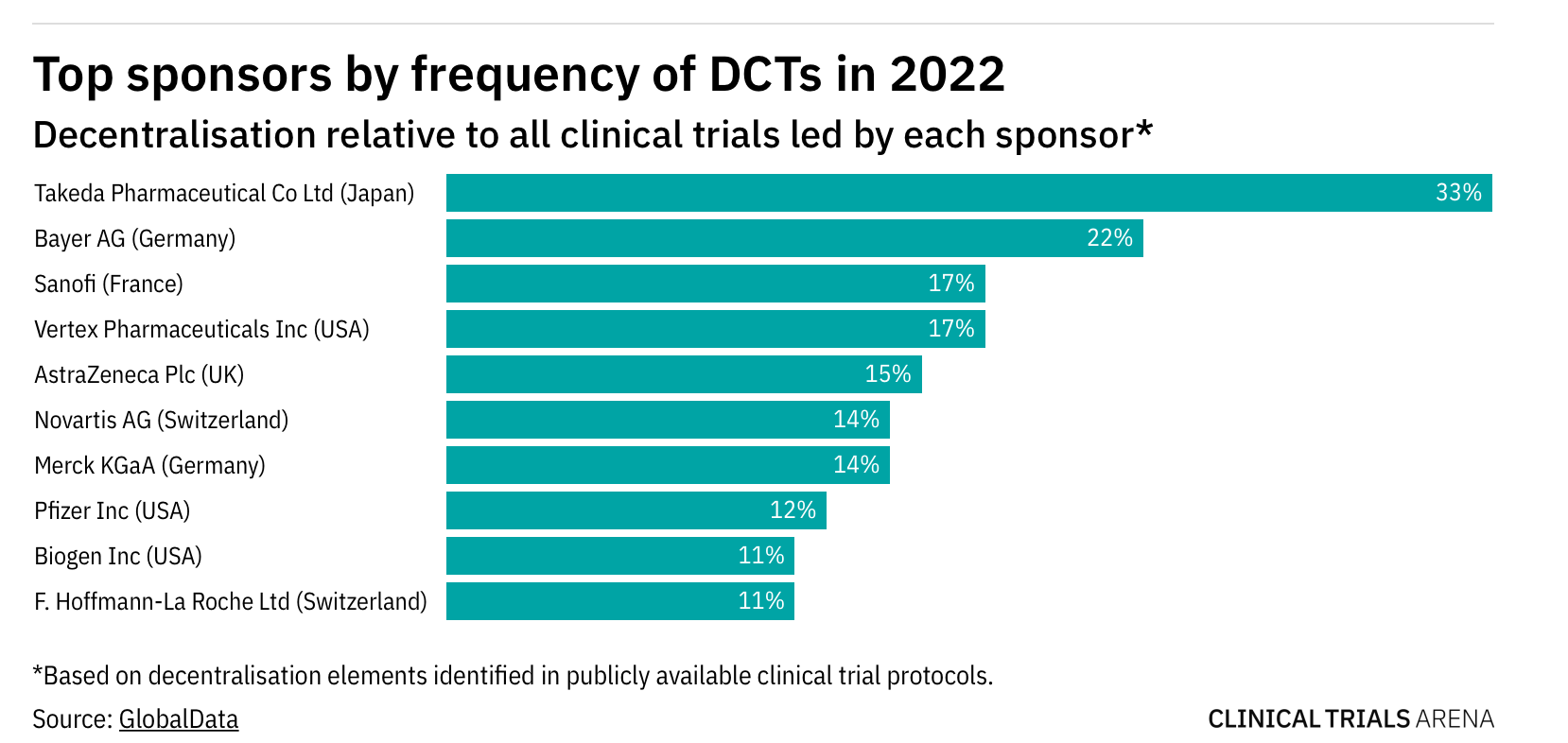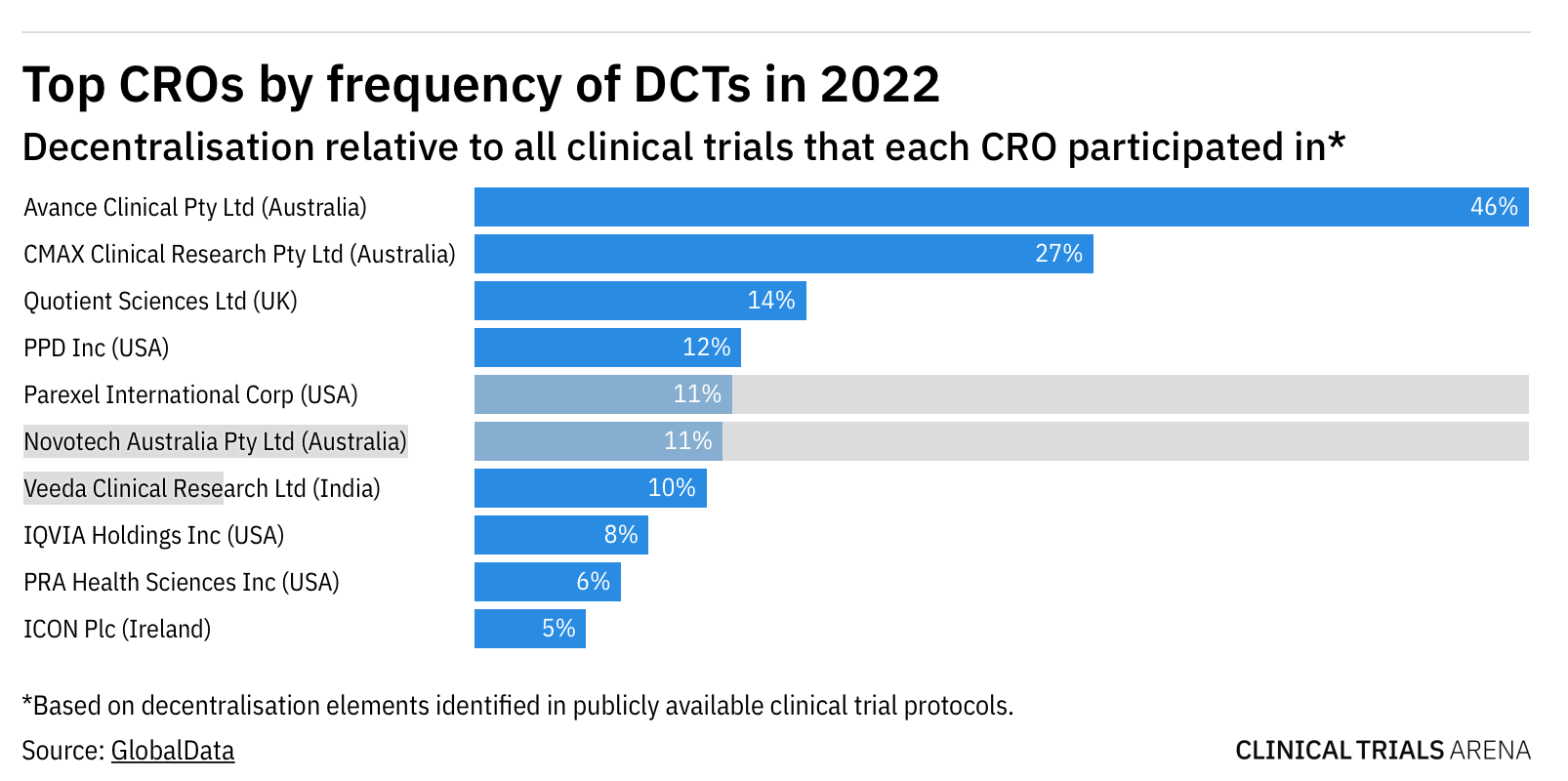As we count down to the end of 2022, we look at the sponsors, CROs, and sites that were at the top of the decentralised clinical trial (DCT) race. We also explore the countries where DCTs were frequently conducted.
Clinical Trials Arena has established an exclusive taxonomic approach that involves reviewing thousands of drug trial public records from 2022 that mentioned decentralisation terminology in the study protocols, as curated in the Clinical Trials Database by GlobalData, the parent company of Clinical Trials Arena. Decentralisation terminology includes DCT elements such as telemedicine, remote monitoring, digital data collection, and more.
Europeans are more DCT prone
The analysis shows that Takeda Pharmaceuticals decentralised 33% of its clinical trials in 2022, followed by Bayer (22%), Sanofi (17%), and Vertex Pharmaceuticals (17%).

To learn which sponsors were using DCT elements most frequently, Clinical Trials Arena exported a list of companies by their R&D expenditure from GlobalData’s Pharmaceutical Intelligence Center. The percentage of DCTs by each sponsor is calculated by dividing the number of DCTs in 2022 over the total number of trials (virtual and non-virtual trials).
While sponsors are not inclined to disclose whether they are using decentralisation elements in their clinical trials, such information can be incredibly useful when it comes to research, especially for real-world evidence or diversity, says Priya Nair, senior clinical trial analyst at GlobalData.
Additionally, transparency can benefit the entire pharmaceutical sector, as smaller biotechs can learn from big pharma companies about how to implement DCT elements in their clinical trials.
There are also benefits to disclosing information about failed trials. “The whole point of DCTs is to help that trial advance to the next phase or bring the drug to market,” Nair says. “If the trial failed, was it because of the DCT element, or why didn’t the DCT elements help the trial?”
DCT becoming a selling point for CROs
The analysis shows that the CROs which participated the most in trials with DCT elements were Avance Clinical (46%), CMAX Clinical Research (27%), and Quotient Sciences (14%).

To calculate the DCT frequency by each CRO, Clinical Trials Arena compiled a list of companies with the highest number of trials (virtual and non-virtual trials) in 2022. The percentage of DCTs by each CRO is calculated by dividing the number of DCTs in 2022 over the total number of trials (virtual and non-virtual trials).
The CRO’s success in the DCT space depends on how well they are trained in decentralisation elements. Nair explains that if a CRO has integrated these elements into its business, it can become a great selling point when working with sponsors. “It takes the weight off the sponsors’ shoulders, and CROs will get more business. It’s a plus point for both sides,” she adds.
Sites and decentralisation
Clinical Trials Arena also looked at which sites were most involved in decentralised trials in 2022. The analysis shows that the sites with the most DCT involvement in 2022 were The National Institutes of Health Clinical Center (23%), University Hospital of Virgen del Rocio (14%), and University Hospital La Fe de Valencia (14%).
To calculate the DCT frequency by each site, Clinical Trials Arena exported two lists of the top 100 trial sites according to the highest number of all trials (virtual and non-virtual) and DCTs alone from GlobalData’s Trial Sites Database. Once combined, 34 sites were present in both lists. Their DCT frequency was calculated by dividing the number of DCTs by the total number of trials. The data visualisation includes sites that have a DCT frequency of more than 6%.
Fully decentralised trials eliminate the need for a site. However, Nair says that sites will not entirely disappear, as certain therapy areas, such as oncology, depend on sites for blood collection or drug administration.
Additionally, patient preference is an important aspect to reduce patient burden. As previously reported on Clinical Trials Arena, some patients prefer to attend onsite as part of the clinical trial, rather than participate remotely. Still, remote sites and mobile research teams can also help ease patient burden by reducing the requirement to travel by bringing the trial to the patient’s home.
DCTs in the world map
The analysis shows that DCTs were more frequent in Western countries compared to Eastern countries, except Australia. The decentralisation of trials was most common in the UK (14%), Australia (12%), Canada (11%), and Poland (11%). The percentage of DCTs for each country was calculated by dividing the number of DCTs by the total number of trials (virtual and non-virtual trials) in 2022.

Nair explains that the higher frequency of DCTs in Western countries is likely due to the better socioeconomic status and regulatory backing to integrate new elements within clinical trials in these countries. Additionally, participants in Eastern countries might be less inclined to disclose information virtually. “They probably have a preference of actually going in and seeing a doctor face to face,” she says.
However, the current trends are not set in stone. Nair says that Eastern countries may catch up in a few years due to technological advancements. “The data we see now is in the process of changing,” she adds.
